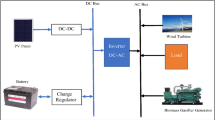Abstract
Brovst is a small district in Denmark. This paper analyses the use of local renewable resources in the district heating systems of Brovst. The present use of fossil fuels in the Brovst district heating plant (DHP) represents an increasing environmental and climate-related load. Therefore, an investigation has been made to reduce the use of fossil fuels for district heating system and make use of the local renewable resources (biogas, solar, and heat pump) for district heating purposes. In this article, the techno-economic assessment is achieved through the development of a suite of models that are combined to give cost and performance data for this district heating system. Local fuels have been analyzed for different perspectives to find the way to optimize the whole integrated system in accordance with fuel availability and cost. This paper represents the energy system analysis mode, energyPRO, which has been used to analyze the integration of a large-scale energy system into the domestic district heating system. A model of the current work on the basis of information from the Brovst plant (using fossil fuel) is established and named as a reference option. Then, four other options are calculated using the same procedure according to the use of various local renewable fuels known as “biogas option,” “solar option,” “heat pump option,” and “imported heat option.” A comparison has been made between the reference option and other options. The greatest reduction in heat cost is obtained from the biogas option by replacing a new engine, where 66 % of the current fuel is substituted with biogas.








Similar content being viewed by others
References
Algieri, A., & Morrone, P. (2014). Techno-economic analysis of biomass-fired ORC systems for single-family combined heat and power (CHP) applications. Energy Procedia, 45, 1285–1294.
Andersen AN, Mæng H (2004). EnergyProGrid—working paper 2 2004. Aalborg, Denmark: Department of Development and Planning, Aalborg University. See also: http://plan.aau.dk/GetAsset.action?contentId¼3592310&assetId¼3614793;2004.
Atli, B., Benny, B., & Hans, F. R. (1995). Operational optimization in a district heating system. Energy Conversion and Management, 36(5), 297–314.
Brkic, D., & Tanaskovic, T. I. (2008). Systematic approach to natural gas usage for domestic heating in urban areas. Energy, 33(12), 1738–1753.
Capuder, T., & Mancarella, P. (2014). Techno-economic and environmental modelling and optimization of flexible distributed multi-generation options. Energy, 71, 516–533–53.
Colmenar-Santos, A., Rosales-Asensio, E., Borge-Diez, D., & Mur-Pérez, F. (2015). Cogeneration and district heating networks: measures to remove institutional and financial barriers that restrict their joint use in the EU-28. Energy, 85(1), 403–414.
Connolly, D., Henrik, L., Mathiesen, B. V., & Leahy, M. (2010). A review of computer tools for analyzing the integration of renewable energy into various energy systems. Applied Energy, 87, 1059–1082.
DONG Energy in 2008, Available from: http://www.dongenergy.dk/erhverv/Naturgas/prisaftale/Listepris/Pages/erhvervspris_sep.aspx
El-Spot (2008). Time values from 2008, Available from: http://www.nordpoolspot.com/
EMD International A/S, energy PRO Users Guide, Aalborg, < www.emd.dk > April 2014.
Fragaki, A., Andersen, A. N., & Toke, D. (2008). Exploration of economical sizing of gas engine and thermal store for combined heat and power plants in the UK. Energy, 33(11), 1659–1670.
Hendriks, C., & Blok, K. (1996). Regulation for combined heat and power in the European Union. Energy Conversion and Management, 37(6–8), 729–734.
Hvelplund, H., Ingermann, F., & Kask, K. (2000). Estonian energy system—proposals for the implementation of a cogeneration strategy. Energy Policy, 28(10), 729–736.
Jurado, F., Cona, A., & Carpio, J. (2003). Modelling of combined cycle power plants using biomass. Renewable Energy, 28, 743–753.
Keiko Hori, K., Matsui, T., Hasuikec, T., & Machimura, T. (2016). Development and application of the renewable energy regional optimization utility tool for environmental sustainability: REROUTES. Renewable Energy, 93, 548–561.
Kong, X. Q., Wang, R. Z., & Huang, X. H. (2005). Energy optimization model for a CCHP system with available gas turbines. Journal of Applied Thermal Engineering, 25, 377–391.
Lund, H. (1999). Implementation of energy-conservation policies: the case of electric heating conversion in Denmark. Applied Energy, 64, 117–127.
Lund, H. (2010). The implementation of renewable energy systems lessons learned from the Danish case. Energy, 35, 4003–4009.
Lund, H., & Andersen, A. N. (2005). Optimal designs of small CHP plants in a market with fluctuating electricity prices. Energy Conversion and Management, 46, 893–904.
Lund, H., & Østergaard, P. A. (2011). A renewable energy system in Frederikshavn using low-temperature geothermal energy for district heating. Applied Energy, 88, 479–487.
Lund H and Østergaard PA. Sustainable towns: the case study of Frederikshavn 100 % renewable energy. Chapter 11.
Lund, H., Moller, B., Mathiesen, B. V., & Dyrelund, A. (2010). The role of district heating in future renewable energy systems. Energy, 35, 1381–1390.
Nielsen EH. Experience of environmental management in the Danish fish-processing industry. In: Environmental management systems and cleaner production. Wiley.
Østergaard, P. A. (2010). Regulation strategies of cogeneration of heat and power (CHP) plants and electricity transit in Denmark. Energy, 35, 2194–2202.
Ro, K., & Rahman, S. (2003). Control of grid-connected fuel cell plants for enhancement of power system stability. Renewable Energy, 28, 397–407.
Ryohei, Y., & Koichi, I. (2002). Optimal design of energy supply system based of relative robustness criterion. Energy Conversion and Management, 43, 499–514.
Torchio, M. F., Genon, G., Poggio, A., & Poggio, M. (2009). Merging of energy and environmental analyses for district heating systems. Energy, 34(3), 220–227.
Acknowledgments
The project has been supported by the European Regional Development Fund, grant no. ERDFN-09-0060. The authors would like to thank Niels From from PlanEnergi for his valuable discussion and contribution in the simulation.
Author information
Authors and Affiliations
Corresponding author
Rights and permissions
About this article
Cite this article
Rudra, S., Rosendahl, L. Techno-economic analysis of a local district heating plant under fuel flexibility and performance. Energy Efficiency 10, 613–624 (2017). https://doi.org/10.1007/s12053-016-9475-2
Received:
Accepted:
Published:
Issue Date:
DOI: https://doi.org/10.1007/s12053-016-9475-2




